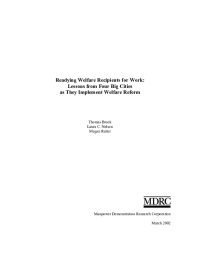Readying Welfare Recipients for Work
Lessons from Four Big Cities as They Implement Welfare Reform
A primary objective of the 1996 welfare reform law, the Personal Responsibility and Work Opportunity Reconciliation Act (PRWORA), is to end poor families' dependence on public benefits by helping them prepare for employment. Part of MDRC's Project on Devolution and Urban Change, this report examines how four urban counties - Cuyahoga (Cleveland), Los Angeles, Miami-Dade, and Philadelphia - have approached the challenge of moving large numbers of welfare recipients into work. Focusing on the period from 1997 through early 2001, the report draws on interviews and observations conducted at the county welfare offices, a survey of welfare office staff, and participation and expenditure data supplied by the counties and the states in which they are located.
Though large welfare bureaucracies have historically been able to ride out pressures to change, after PRWORA's passage the sites in the Urban Change study made important policy and operational changes directed at moving welfare recipients into the workforce. Designing and implementing these changes took several years and considerable financial and human resources. Three of the four counties shifted from an emphasis on education and training to a "work-first" approach (Los Angeles had already moved in that direction by the time PRWORA was passed). All four counties also made substantial strides toward increasing the percentage of welfare recipients who were employed or participating in welfare-to-work activities. Finally, despite falling caseloads, spending on welfare-to-work programs increased dramatically in all the counties. The changes did not always proceed smoothly. For instance, state and local policymakers sometimes clashed over program objectives, and case managers - who play a critical role in linking recipients and policies - sometimes struggled to fulfill their increasingly complicated responsibilities. Supplementary funds for serving hard-to-employ recipients were available through the U.S. Department of Labor's Welfare-To-Work grant program, but only Philadelphia made extensive use of them. All the counties continue to search for effective strategies for working with the hard-to-employ.
The report's key findings and observations include:
- Welfare administrators in the counties supported PRWORA's emphasis on rapid employment. For many administrators and staff, looming time limits on cash welfare assistance lent new urgency to the goal of getting clients into jobs or job preparation activities.
- Declining caseloads and the TANF block grant structure left the counties with substantially more money to spend on welfare-to-work activities than had been available in the past. They used the funds to hire more case managers and to expand program capacity, which enabled them to extend welfare-to-work mandates and services to a larger proportion of the caseload.
- The most common welfare-to-work activity in all four counties in 1999/2000 was work itself, followed by job search and short-term vocational training. Few participants were engaged in basic or postsecondary education. Only two of the counties ran substantial community service or unpaid work programs.
- One important factor behind the increase in the proportion of recipients who were employed is state earned income disregard policies that allowed recipients to raise their monthly income by combining earnings and benefits and that boosted the counties' welfare-to-work participation rates. It is important to note, however, that welfare recipients who combined work and welfare generally used up valuable months of welfare eligibility.
- The counties' emphasis on job search and short-term activities made sense in the strong economy of the late 1990s. The recent economic downturn may call for more spending on training and subsidized jobs.
- Although the counties adopted strikingly different sanctioning policies to address noncompliance with work requirements, participation rates were roughly similar regardless of whether enforcement was strict or lenient.
Funded by a group of private foundations and federal agencies listed at the front of the report, the Urban Change study examines PRWORA's implementation and how it has affected welfare recipients, low-income neighborhoods, and organizations that serve the poor in big cities.







